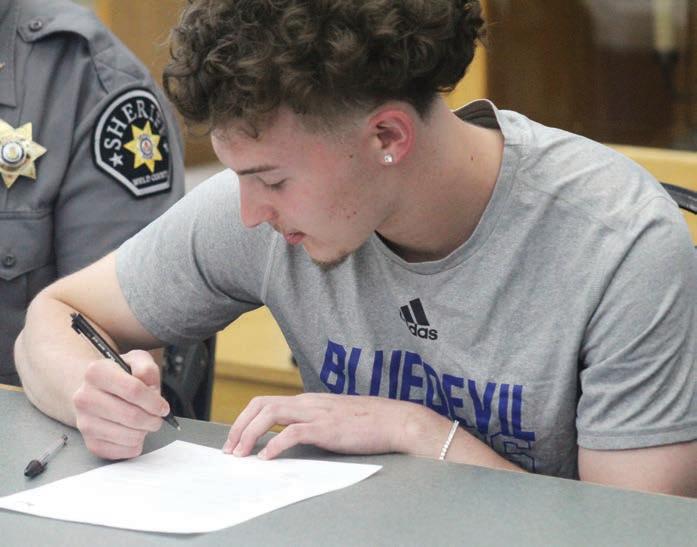
58 minute read
SPORTS
BY STEVE SMITH SSMITH@COLORADOCOMMUNITYMEDIA.COM
There aren’t many people who can say they are thankful for anything to do with the pandemic.
Fort Lupton’s Conner Moll can.
“The pandemic closed a lot of gyms. I had to fi nd parks and stuff to go to,” Moll said. “It messed up the recruiting process. A lot of colleges were like, ‘We love you. We don’t have the money for it.’ It played a huge part. At the end of the day, everything happens for a reason.
“I’m grateful for COVID now,” he added. “It was a hard few years. It really helped me out.”
Moll signed a collegiate letter of intent May 26 to play basketball and study business entrepreneurship at Keiser University in Fort Lauderdale, Florida.
“Honestly, I had no idea about it until my mom found it,” Moll said. “I was sending emails out. I was trying to do anything to fi nd a school. My mom was like, ‘Go to Duke University,’ things like that. I was like, ‘Let’s be realistic here.’”
Moll went to a Keiser-sponsored camp at Colorado Christian University in Lakewood.
“I was actually hoping to be signed by Colorado Christian so I can stay in state,” he said. “But I met the coach. You could tell he was watching for me. I thought this might be the place. He defi nitely did his work and tried to make it possible so I could go there. It showed me he wanted me. It wasn’t an athlete for him to sign.”
Moll and his mother took a campus visit.
“He took care of my mom and I very carefully,” Moll said. “We did a lot of stuff besides looking at the basketball side and the academic side. It sealed the deal when we went out there. I was looking at two others. It was basically no contest after I found this one.”
Outgoing athletic director Cora Lanter called Moll “a real student and an athlete.”
“I saw a positive person in the hall,” she said. “He never found his way to the offi ce for anything. That’s tough to do as a senior, to maintain that poise.”
FLHS boys basketball coach Jim Roedel called Moll “a leader who has the ability to do anything you want.”
“You have friends who care about you. You have a school here that will help you,” Roedel said. “For you to come here, in a town this size and accomplish what you did here? I am proud of you.”
Moll wants to start a clothing business this summer. The eventual goal is to own his own business with his own style of clothing.
“I am not big on Colorado. I love it because it’s my home. And I love Fort Lupton, and it will always be home,” Moll said. “But I’ve wanted to move to a bigger city. I don’t like the weather here. It’s nice in the Sunshine State. I love the humidity, too. My parents hate it. Right now, it’s looking like my new home.”
“You are a great athlete, and you have amazing parents,” said outgo-
Test kits can be requested online at www.drhomeair.com/weld, accord-
ing FLHS Principal John Biner. “Nobody sits where you are sitting by yourself. You are great in the hallways, and you are fantastic to watch playing basketball.” “I haven’t been nervous or scared. I’ve done everything I can to prepare myself for this moment,” Moll said. “It feels like more of an accomplishment and in Adams County can receive up to a pat on my back to myself for all the hard work I’ve put in.”

Fort Lupton’s Conner Moll puts pen to paper May 26 and signs his letter of intent for college basketball and business studies at Keiser University. PHOTO BY STEVE SMITH
Frederick’s Justice getting his work in ... and loving it
Basketball standout will play the sport year round with eye on state title
BY STEVE SMITH SSMITH@COLORADOCOMMUNITYMEDIA.COM
FREDERICK -- It’s been just about two months since Frederick High School’s boys basketball team fi nished its fi rst appearance in the Final Four since 1956.
But Luke Justice isn’t wasting time. The soon-to-be Frederick senior is playing on a traveling AAU team plus a high school club team this summer. He has some goals in mind — a player of the year honor, a state title next winter, to be the best teammate possible and a spot on a college roster in a year’s time.
His interest in basketball started at the age of 3, and it was his mother who pushed him in that direction.
“She had offers in college for basketball and soccer, but she was really big on basketball,” Justice said. “She wanted me to play, and she taught me everything. My dad wanted me to play, too, so I have to thank my mom and dad.”
Justice said basketball wasn’t his best sport at fi rst.
“I was actually a better baseball player (he was a pitcher) than I was a basketball player,” Justice said. “I miss baseball. When I was 12 years old, I was in the state championship in Maryland before I moved out here. I threw my arm out in the middle of the game. We ended up going to a doctor, and he said if I continued pitching, I was going to tear a ligament. I would have had to get surgery, so I had to quit playing baseball.”
Year-round participation
Like a lot of high school players in his sport and others, basketball is a year-round sport for Justice.
“I miss the fun activities,” Justice said. “I always enjoy watching football. I wanted to play it at one time. I miss out on the activities like summer time when everyone is in the pool or hanging out.
“I feel like it’s always worth it,” he said. “Basketball is my fi rst love.”
Wanting to improve on a good season
FHS was 21-5 this season and won the class 4A Longs Peak League title. For his part, Justice averaged 13 points a game and sank a pair of key 3-pointers in a playoff win over Mead.
“Coach (Jeff) Conway has already told us that we were an unknown coming into this (recent) season — that no one expected us to be good (FHS hadn’t won a playoff game since 2012),” Justice said. “Because they know we were in the Final Four, every team is going to be giving us their best effort. We’ve got a bullseye on our back.”
There are some differences between high school play, club team play and AAU play.
“Around AAU time, that’s where I work with my coaches and a trainer,” Justice said. “I work on my skills, see what I can do with the ball, pick and roll. It’s more of a one-on-one type thing. When it goes to high school, it has to be a team effort. In AAU, you put fi ve guys out there, and it’s skill basis. In high school, you can be upset by a team that gels.
“My AAU coach, Coach (Brandon) Brown (the new coach at Cherokee Trail High School), has done really well with me,” Justice added. “He’s given us the idea of treating this like a high school game. If you can play defense, you can win. Practices are more like one-on-one. It’s very competitive.”
In closing
Justice earned all-state honorable mention this year and a fi rst-team, all-conference citation. He thinks the Warriors will be a solid team next season, even though they have to fi nd replacements for Alex Sturn, the coach’s son, Jacoby Conway and Bryce Conover.
“When I go to a park and see kids play, it makes me happy,” Justice said. “Basketball is such an important sport. It gives people opportunities, maybe make a future out of it. It makes me want to play even more.”
There was a time when Justice didn’t want to continue, though.
“I came home from my fi rst practice. I was making mistakes, turning the ball over. I came home, crying, and I told her I didn’t want to play any more,” he said. “My mom said, ‘There’s no reason to cry.’ She took me back outside after practice. We shot around for another hour and a half. She told me to never give up. “I always thank my mom for that.”


Luke Justice
Action comes a week after Bu alo shooting, day before Uvalde, Texas, shooting
BY LUKE ZARZECKI LZARZECKI@COLORADOCOMMUNITYMEDIA.COM
Westminster City Council designated June 3 as Prevention of Gun Death Awareness Day by proclamation May 23.
The vote comes a little over a week after 10 people were killed in Buffalo, New York, in a supermarket shooting. The day after Westminister’s vote, a gunman shot and killed 19 children and two teachers in Uvalde, Texas.
According to the Gun Violence Archive, there have been at least 213 shootings with four or more people killed or injured so far this year.
“Americans support the Second Amendment Right to bear arms, to protect life and property and to protect oneself and family,” the city’s proclamation stated. “There is recognition in the inherent responsibility required to own a gun.”
City Councilor Obi Ezeadi said the proclamation is not only a win for gun death awareness but also for City Council. He and City Councilor Bruce Baker negotiated the terms of the proclamation through eight different drafts and came to an agreement.
“This was a negotiation,” Ezeadi said. “This was a ‘let’s fi nd common ground that addresses the issue from all sides.’ Not just my side, not just your side, but from all sides.”
Ezeadi said the proclamation reveals the council’s priorities.
Leslie O’Brien of the local Mom’s Demand Action group championed the proclamation. Mom’s Demand Action is a national movement fi ghting for public safety measures around gun violence.
“This is the fi rst gun awareness day Westminster has ever voted on as a proclamation,” she said. “This is a huge step for the city.”
She said the group has sent the proclamation to municipalities around Colorado for approval each year for the past eight years. This is the fi rst year Westminster approved it.
Northglenn has approved it in the past, and Thornton has never acknowledged it, according to O’Brien.
During the meeting, Ezeadi touched on his personal experience with guns. He talked about how he was robbed at gunpoint as a preteen in New Jersey.
“He pointed the bow of his gun (and) it touched the skin of my forehead,” he said. “The one thought I remember having in that moment was ‘please don’t kill me.’”
Ezeadi talked about a single mom he knew who murdered her daughter and then died by suicide.
“Westminster, we’ve gone through a few of these as well,” he said.
O’Brien said the purpose of the proclamation is to raise awareness, and that’s why it was important for the council to pass it.
“It’s really to honor and acknowledge survivors and victims of gun violence in our country and as we’re healing from Buffalo, Texas,” she said. “We’re a nation that is broken, and we need to bring awareness to it.”
She said the state of Colorado has passed legislation regarding gun violence prevention, and to do more than just a proclamation, Westminster can educate children and adults around extreme risk protection orders.
She said these orders are similar to reg fl ag laws. If someone is at risk to themselves or others, a court order can be issued to physically remove guns from that person’s home, she said.
“In the wake of all of these horrifi c things, if we can do better, why aren’t we?” O’Brien asked.
‘We cannot become numb to it’: Colorado leaders react to elementary school shooting in Texas
BY KYLE COOKE ROCKY MOUNTAIN PBS
Familiar feelings of dread set in May 24 after a mass shooting at an elementary school in Uvalde, Texas. An 18-year-old gunman opened fi re in classrooms, killing at least 19 children and two adults.
The attack happened at Robb Elementary School in Uvalde, a predominantly Latino town west of San Antonio. Law enforcement offi cers reportedly killed the shooter.
Nearly 1,000 miles away in Colorado, state leaders reacted to the tragedy with a common message: shootings of this type are hauntingly familiar, and action is needed to prevent similar massacres in the future.
“Another senseless tragedy and another painful reminder that we must act,” Denver Mayor Michael Hancock said in a series of tweets. “Prayers and thoughts mean well. They are indeed comforting. But action is better. We as a society have to act.”
“This morning I visited Mancos Elementary School and saw the joy on the faces of students and teachers in their last week of school as they looked forward to new adventures this summer and next school year,” Colorado Gov. Jared Polis said. “Now fourteen students and a teacher at Robb Elementary School in Uvalde, Texas had their joy ended forever from a cold blooded attack and their parents, friends and families won’t ever hold them in their arms again or be able to watch them grow. Colorado’s hearts are heavy for our friends in Texas and join in showing love for the families and community affected.”
Polis released his statement before the full death toll was reported.
The Uvalde shooting happened just 10 days after a racist attack at a Buffalo grocery store that left 10 people dead. And this year alone, there have already been 27 school shootings, according to data from Education Week. Renewed calls for gun control legislation arose following the tragedy in Uvalde.
“This horrifi c gun violence is uniquely American. We cannot become numb to it,” tweeted Democratic Sen. Michael Bennet of Colorado. “We need to act and #EndGunViolence now.”
For his part, Sen. John Hickenlooper (D-Colo.), who was serving as the Governor of Colorado during the Century 16 movie theater shooting in Aurora, said, “As a parent, I weep. Our children deserve so much better than this nightmare. We need to protect our future from this senseless violence.”
Democratic U.S. Rep. Ed Perlmutter of Colorado said, in part, “We cannot lose more children or loved ones. We must fi nd a way to solve our country’s gun violence epidemic & save lives.”
Republican U.S. Rep. Lauren Boebert, a staunch supporter of gun ownership who once said she would bring a handgun to Congress, encouraged people to “turn to God for comfort and healing,” later adding from her campaign’s Twitter account that “You cannot legislate away evil.”
Craig Nasion, a survivor of the 1999 Columbine High School shooting, said, “This is America. There is no end in sight for the steady cadence of mass gun violence we seem unwilling to ever address. A reality my peers could not have imagined on our worst day in April 1999.”
President Biden delivered a televised address May 24 to talk about the Uvalde shooting.
“Why are we willing to live with this carnage?” the president asked. “Why do we keep letting this happen? Where in God’s name is our backbone to have the courage to deal with it and stand up to the [gun] lobbies? It’s time to turn this pain into action.”
As Biden emphasized in his remarks, most Americans support legislation that would help curtail gun violence. But such bills have been nonstarters in Congress, largely due to the fact that they would require Republican support in order to pass. Less than a day after the shooting in Uvalde, several GOP lawmakers have already made it clear that they would not support gun control legislation. Some are instead advocating for arming teachers, a policy that is unpopular on a national level.
After the shooting in Uvalde, NPR spoke with Ron Avi Astor, a mass shooting expert and professor at UCLA, who said he is unsure why gun laws have barely changed since the Sandy Hook shooting 10 years ago.
“Maybe it is money. Maybe it is the gun lobby. Maybe it’s become politicized and an ideological thing,” Astor said, “but [gun violence] should be treated as a public health measure.”
PAID ADVERTISEMENT
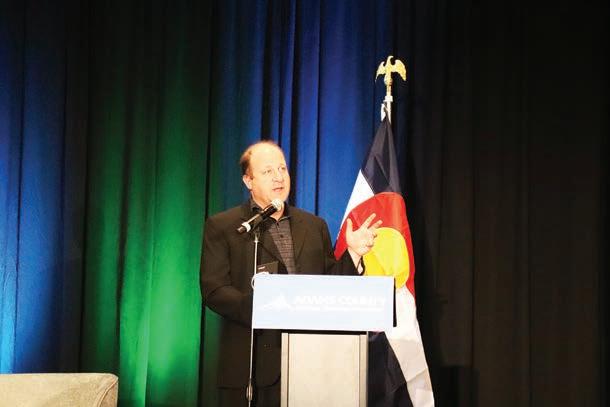
What investors can – and can’t – control

World events can shake up the financial markets – and your investment statements. During periods of volatility, it’s important to focus on the things you can control.
For starters, don’t overreact to short-term price drops – hasty decisions are rarely the best ones.
Also, make sure you identify your short- and long-term goals and create an investment strategy to meet them. And commit yourself to investing regularly – in up, down and sideways markets. If you take a “time out” from investing due to market volatility, you could miss out on the next upturn.
Finally, build a portfolio containing a mix of investments that reflects your goals, risk tolerance and time horizon.
The world will always be filled with unpredictable, uncontrollable events, and many of them will affect the financial markets. But within your own investment world, you have a great deal of control – and with it, you have the power to keep moving toward all your important financial objectives.
This article was written by Edward Jones for use by your local Edward Jones Financial Advisor.
www.edwardjones.com Member SIPC Governor Jared Polis and other Colorado lawmakers made statements regarding the elementary school shooting in
Texas. PHOTO BY LUKE ZARZECKI



Denver dough


2 young pastry chefs create out-of-this-world culinary experience
BY RYAN ERNSTES SPECIAL TO COLORADO COMMUNITY MEDIA
Space dinosaurs. Project 626. Murder by the Campfire.
This is not a list of the internet’s latest conspiracy theories, but rather the creations of Black Box Bakery, a spacethemed wholesale and online retail bakery located in the RiNo district of Denver. And the baked goods look just as outlandish as they sound. Scroll through the bakery’s Instagram feed, and you will find rainbow pastries, croissants that are apparently stranded on Mars, and alien-decorated cookies reading “You’re Out of this World” — all of which are as drool worthy as they are bizarre.
And the Earthly masterminds behind these edible creations? Twenty-seven-year-old Arielle Israel and 24-year-old Megan Read.
Israel stands at 5’3” but carries herself with a certain defiant confidence and clarity of vision. Her reputation for croissants has earned her the nickname “The Laminator.”
She sometimes spends up to 12 hours a day on the laborious work of folding butter sheets into dough, folding it, running it through the sheeter to flatten it and repeating.
Working with dough lets Israel be aggressive, whereas Read handles the more precise aspects of production. Read’s perfection of cakes and pastries gives her the moniker “Cake Queen.” Her energetic, can-do attitude matches the bright auburn of

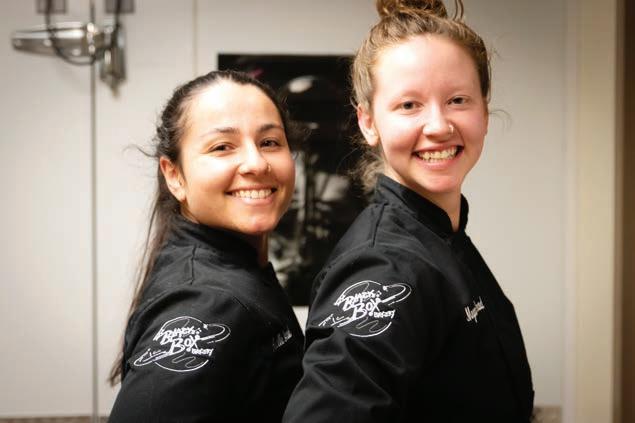
Megan Read
DOUGH
FROM PAGE 12
her hair.
Together, Israel and Read’s days go something like this: 2:30 p.m. to 12 a.m., pastry and croissant production; 12 - 1 a.m., packing; 1 to 3 a.m., deliveries; 3 to 11 a.m., sleep; and 11 a.m., wake up and start thinking about creating all over again.
Business takes off
Israel and Read’s creations come to life in the windowless basement of the Renaissance Hotel in downtown Denver, itself a story with intriguing origins. Just a few months after starting Black Box, Israel and Read received an email on behalf of the CEO of a large hotel conglomerate, asking them to meet in a specified location to “discuss certain opportunities.”
The exchange had all the veiled secrecy of an interaction with the mafia, Read said. But low and behold, the mystery executive was a huge fan of their croissants and wanted to help launch the business to even higher places. The exchange eventually helped Israel and Read land their current workspace in the unused banquet kitchen of the hotel.
Israel and Read’s kitchen now gives them enough space to work alongside four other employees, including Israel’s husband and partner in Black Box, Ty Webb. The team goes to work aerating butter, cutting dough into circles and bathing their pastries in egg washes, which gives the final product that delectable golden-brown hue. Sometimes the crew listens to podcasts to stay entertained. Some of their favorites include “Serial,” “Stuff You Should Know” and “Behind the Bastards.”
On occasion, Israel might share her other hobby with Read — watching surgeries online. As it turns out, you can witness surgeons remove a blockage of the heart on Instagram and learn to spot the difference between a ruptured spleen and an intact one. Macabre? Maybe a little. But Israel thinks the interest stems from a desire to understand how things work.
In baking, for instance, Israel must understand how each ingredient will change her final product. It was in culinary school that she first realized “the egg has this function; the sugar does this,” and so forth. Read does not share the same affinity for watching medical operations, but the two clearly have a long history of knowing each other’s quirks.
Dynamic duo
The pair go back to 2015, when they began their associate’s degrees at the Culinary Institute of America in New York. Israel was 20, having just completed her mandatory two years in the Israeli army, and Read was only 18. The two partnered up for a class and it immediately became clear they made a great team.
“She does all the things that I’m not good at or don’t like, and I’m the same for her,” Read said.
For the next few years, Israel and Read worked together in classes and at restaurants on the weekends. Their connection became almost telepathic, each knowing what the other would work on without having to communicate it.
After graduating from culinary school, Israel took a job as a pastry chef in Denver. Meanwhile, Read had just completed her manager’s training at a restaurant in New York. But Israel saw the opportunities on the horizon and knew, “I need my partner.” She sent a formal job offer over to Read, and within a month, the dynamic duo was reunited.
Soon after, Israel and Read decided it was time to branch out on their own. A colleague in the industry introduced them to the concept of wholesale production: making baked goods to be bought by other cafes and restaurants. It was just what Israel and Read needed — a way to get their foot in the door without the high startup costs of running their own storefront.
Thus, Black Box Bakery was born. Their specialty? Laminated pastries: anything made through rolling and folding layers of dough and butter. If it sounds decadent and delicious, that’s because it is.
Exploring the creative possibilities
But Israel and Read had no desire to create “just another bakery.” Instead, they wanted to explore the unknown and embark on a journey of discovering what’s possible in the culinary sphere.
“It allows us to say, ‘you know, we’ve never seen a blue croissant before. We’re gonna do that,’” Israel said.
And indeed, the bakery abounds with creativity and variety. Croissant varieties include strawberry, almond, Oreo, pistachio and cruffin — a cross between a cinnamon roll and a croissant.
As for the bakery’s out-ofthis-world theme, Israel loves all things alien and conspiracy theory. She sees a metaphorical connection between her croissants and space, both whimsical, mysterious entities in her mind.
“People at home don’t know how croissants are made,” Israel said.
And that same principle could apply to much of space, too.
Once, after a long night of deliveries for the bakery, Read even had a firsthand experience with a UFO. In the dark, early hours of the morning, Read was driving home and spotted something in the sky that looked like a planet but was crazy bright. She immediately called Israel to describe what she was seeing.
“All of a sudden it zoomed across the sky,” said Read emphatically, using her hands to mimic the quick trajectory of the unidentified object. She told Israel, “Bro, I think I just saw a UFO.”
Paranormal or not, Israel and Read seem to draw inspiration from particular formative memories.
Like the first time Read tried a croissant in France. She entered a random bakery, stopped to pick up a croissant, and was walking to the subway when she took her first bite. It literally stopped her in her tracks. The sweet, grassy taste of the butter was like nothing she had ever tried before. Read wants this to be the visceral experience all people have when they taste Black Box’s goods.
Much of Israel’s inspiration is rooted in personal experiences too. Growing up, she would spend summers with her grandparents in France. Each day, Israel would stand in line for fresh baguettes and croissants — even if they still had leftover baked goods at home from the day before.
And at her childhood home in Israel, Friday nights were dedicated to food too. Israel would make challah bread, always met with constructive criticism driving her to be better.
“Too dense, could be better,” her family members would coach her.
Those memories stick with her. And now, Israel and Read long to produce baked goods that transport people to cherished memories of their own.
Storefront on the horizon
Back in the kitchen, the clock has struck 2:30 p.m., which means production has begun. Occasionally, Israel and Read chatter with the team as they work. Other times they seem overcome by a quiet, determined focus, despite performing the same repetitive tasks they do day in day out.
It is clear the two take great pride in their work.
“They have a standard and will have that standard met no matter what. And if it isn’t met it doesn’t go on the plate,” said Blake Ritenour, close friend and former employee.
That standard is producing results. Due to their success, Israel and Read look forward to opening their first storefront bakery in late summer or fall of this year. It’s a space in the Edgewater Public Market, a hip food hall in west-central Denver.
“It’s a dream,” Israel said. “Everyone wants to see their products and get that feedback” from their customers.
Despite their impressive accomplishments at a young age, Israel and Read are not pumping the brakes anytime soon. They are already dreaming about owning a restaurant, a hospitality group, a desert bar and a diner. They excitedly blurt out ideas, feeding off one another’s infectious enthusiasm.
On reflection, “I can see this getting, not out of hand, but... out of hand,” Read said, laughing.

Arielle Israel, left, and Megan Read, right, share a passion for top-notch baked goods and are the masterminds behind out-of-this world Black Box Bakery.
PHOTO RYAN ERNSTES
Here’s where facilities for electric vehicles are going in Colorado
BY MICHAEL BOOTH THE COLORADO SUN
Sitting in an electric vehicle with only 25 miles of range left in the battery, far from home in the cellphone waiting lot at Denver International Airport, a half hour of time to kill and a Dunkin’ donut shop beckoning with sustenance … what better place for a fast charger station, right?
Not yet, as frustrated EV drivers have discovered and struggled to fathom.
But there could be soon, responds the Colorado Energy Office, the agency charged with overseeing buildout of the hundreds of thousands of public and private charging stations needed to fuel the state’s goal of nearly 1 million EVs on the road within eight years.
There are slower chargers in the DIA parking garages. Fast charging stations built by private companies around DIA’s edges, like the neon-green glowing Electrify America juicer at East 57th Avenue and Tower Road. And yes, airport and state energy office officials say, the popular cellphone lot, gas station and food court next to DIA is a logical spot for a gleaming bank of rapid-charge stations that probably should have happened already.
Electrify America, with a simple consumer interface and plugs that can put 50 miles of range into a car within a few minutes, is “the recipient of an award from CEO to build stations at the cellphone lot, I’m guessing within the calendar year,” said Christian Williss, who directs transportation fuels and technology for the energy office.
Analysts say that kind of government-assisted growth is helping Colorado keep pace with EV sales that rank among the top states in the nation. Publicly financed chargers in high-traffic locations have been a success, they say, with the state’s interstate-focused network regularly adding completed stations.
Now the challenge is to make the charging system equitable by getting more everyday home chargers installed at relatively stubborn locations like thousands of small apartment complexes, work sites where cars are parked all day, and in rural towns with long distances between chargers.
EV chargers Walsenburg Colorado Springs EV Club Curtis Claar
“We need to prioritize charging in multifamily housing, as well as workplace charging, given the importance of charging at these locations,” Williss said.
Drive Clean Colorado, a nonprofit promoting equitable clean energy transition, agrees that while most visible en route charging needs that address range anxiety are getting built, the true need is expansion of locations where everyday commuters will actually charge up: Overnight at home, and at the workplace.
“Keep in mind that most people drive less than 40 miles a day, and most cars are parked for hours at a time,” said Drive Clean Colorado Executive Director Bonnie Trowbridge. “So I’d love to see us focus more on EV charging wherever we see parked cars, whether that is in your own garage or driveway, the grocery store parking lot, or long-term parking at the airport.”
Colorado is doing well to keep up so far, and is even a bit ahead in the charging game, according to analyst Jesse Toprak with the EV subscription company Autonomy. (Autonomy’s subscription operates like a lease, but allows people to try EVs without a longterm commitment.)
EVs can be plugged in on 120volt home circuit, or Level 1, charging at about 3 to 5 miles of range an hour. Level 2 chargers can be bought for the home and are the most common in public spaces, and can charge anywhere from 12 to 80 miles an hour. Level 3 or DC chargers are being added at important highway stops and as neighborhood filling stations, at up to 20 miles of range per minute.
With about 54,000 EVs currently on the road in Colorado, there are 4,150 fast charging ports at Level 2 or 3, Toprak said.
That’s about 90 combined Level 2 and DC fast charging ports for every 1,000 vehicles, better than the U.S. Department of Energy recommendation of about 43 ports for every 1,000 EVs, Toprak said.
“However, we expect an exponential increase in the number of EVs in Colorado, particularly in Denver, in the coming months and years,” Toprak said. “Therefore, there is clearly a need for the charging infrastructure to keep up with this jump in demand.”
Colorado has made $20 million in charging station grants in eight years of the state-run Charge Ahead Colorado program, Williss said. About 1,700 stations have been completed around the state, with applications for state help open to private companies, nonprofits, community groups or towns, and building owners.
For a Level 2 charging station, Colorado gathers federal, state and Volkswagen lawsuit settlement funds and can cover up to 80% of the cost, up to $9,000, Williss said. For the extra-fast DC chargers, the 80% grants can be $35,000 or $50,000, depending on speed.
The grants continue to be popular, with three or four applications for every grant slot. That’s why the addition of millions in federal stimulus funding for every state’s electrification efforts will be welcome, he said.
“We’re pleased with additional funding that is coming down the pike,” Williss said. “I think that will help to address some of that demand, although I suspect it will continue to be oversubscribed.”
State and federal officials are also counting on privately led efforts to further develop the charging network.
Electric truck and SUV maker Rivian, now delivering dozens of back-ordered vehicles to Colorado customers, is creating a Rivian Adventure Network of fast chargers. The first Colorado adventure station will open in Salida in June, with DC fast chargers proprietary to Rivian vehicles that can add up to 140 miles of range in 20 minutes, and open network Level 2 chargers for non-Rivian EVs.
Rivian is already opening up public charging stations with its brand name at every state park. Those stations charge all EVs, not just Rivian, and first opened at Cheyenne Mountain State Park in Colorado Springs. Rivian




EV drivers su ering range anxiety in and around Denver International Airport now have a glowing Electrify America fast charge option nearby at 57th Avenue and Tower Road, though charge station builders have not yet completed all the consumer-friendly
touches like obvious signage or uniform payment interfaces. PHOTO BY MICHAEL BOOTH/THE COLORADO SUN
No Clipping Required.
The AARP® Auto Insurance Program from The Hartford.1
FREE duffel bag when you request your free quote!3
ON AVERAGE, AARP MEMBERS ENJOY $5072 SAVINGS
ON AUTO INSURANCE when they switch from companies like GEICO, State Farm and Allstate
Your savings could be even more!
Call The Hartford 1-833-498-1989
Call The Hartford now to request a FREE money-saving quote. 1-833-498-1989
Here’s what you can do to help prevent them
BY RACHEL ESTABROOK COLORADO PUBLIC RADIO

In the time since a gunman killed 10 people inside a grocery store in Buffalo, New York, it’s becoming clear that the suspect left warning signs about his attack, which is being investigated as a hate crime due to his racist online writings. His actions and words raised red fl ags in school and in online communities, but no one intervened to help prevent the attack.
Colorado is a hotbed for research and developing strategies to help prevent bias-motivated crimes, and experts here have ideas about what people can do in their daily lives to help stop attacks like the one in Buffalo, or a similar one in an El Paso Walmart in 2019, which targeted Latinos. It’s not just mass murder making this prevention work urgent right now: The Anti-Defamation League has noted 204 instances of white supremacist propaganda and incidents in Colorado in 2021 and 2022.
Psychologist Rachel Nielsen spoke with Colorado Matters about strategies for prevention. She is working on a project to fi ght targeted violence, which will roll out training for K-12 schools and colleges and universities starting in July. The project is in partnership with two groups born out of the Columbine massacre — the Frank DeAngelis Center and Nicoletti-Flater Associates — and it’s funded by the U.S. Department of Homeland Security. This is an edited transcript of our conversation.

How can we stop hateful ideologies from taking root?
The educational culture and the values of a school have a lot to do with mitigating these things early on in life, because freedom of speech goes so far in the U.S. A lot of hate speech falls under freedom of speech. So it comes down to our communities, our schools, and our faith organizations to draw the line about what we fi nd culturally and socially acceptable way before it’s something criminal.
In mission statements and value statements of school, for example, is it written in school policy that it’s unacceptable and there are consequences for saying something racist to a peer? It really does come down to everyone taking up the charge and pushing for a positive, diverse, inclusive environment at schools.
How can an inclusive message be taught when prominent fi gures, including Congresswoman Lauren Boebert in Colorado, promote racist ideas like “replacement theory”?
I don’t think it’s ever too late, but these things do ebb and fl ow in our country. In recent years, we defi nitely have seen more racist attacks in the name of white supremacy or alt-right rhetoric. It is becoming mainstream.
That’s part of the problem for


As shootings and crimes rise in the U.S., Colorado Public Radio looks at how to prevent hate crimes in local communities. SHUTTERSTOCK
young people, because their critical thinking is still developing. They’re not sure where to get correct information. When they hear disinformation or misinformation come from people in power, like politicians, a vulnerable young person might be more likely to believe that this is the case, and then that becomes fuel on the fi re for someone who’s already angry, has a sense of personal grievance, and then latches onto a hate ideology.
Many people will espouse hate beliefs and not violently attack another individual. But when that voice becomes more of a mainstream opinion, then you can have people who are vulnerable to this pathway to violence who are more emboldened, because it is more familiar and common.
What should I look out for in terms of red fl ags before someone potentially becomes violent?
Usually, we notice that our loved ones are changing in some way. What we found in bystander research is that friends and family have the greatest infl uence and the greatest opportunity to catch it early, well before it would come onto the radar of a professional, like a mental health counselor or an educator. So we encourage that when somebody starts – for the fi rst time – saying things about violence or hate, or suggesting that that’s the answer to social or political issues, that we confront that by having a conversation and not shying away from it.
How should I have that conversation?
Social media can be one of the worst places to have a conversation about ideologies, because it easily becomes divisive. A face-to-face conversation would be best, since there can be some dialogue.
If someone says something that I have never heard them say before, like something racist, as uncomfortable as that would be, I would want to say, “I’ve never heard you talk like that. Why are these things appealing to you? What’s changed with you?” Actually express concern about them, that something is off and they’re becoming angry and blaming people, which is really a warning sign.
If, instead, you come with the opposite opinion, or try to use facts to dispute someone’s beliefs, sometimes it ends up having the effect of making you impossible to talk to. They think you’re the “other,” or shaming them, and they will pull away, and then maybe they won’t express these things to you, but they can continue to get more strident.
What if I’m worried about getting someone in trouble by calling the police?
There’s federal research that found that in any given attack, there are three people, usually friends and family, who had real information about what their loved one was going to do, but they probably didn’t know what to do with it.
The top reason that people don’t report the information is that they’re afraid to get their loved one in trouble and they don’t want to overreact, or for the loved one to get mad at them. This is especially true with teens and young people; they don’t want to get their friend in trouble, or they don’t want to get in trouble with them.
Luckily, in Colorado we have Safe2Tell. That works well for these kinds of concerns, about a kid who may have a gun on campus or has insinuated that they will hurt somebody. But the problem is, very much like what happened in Buffalo and even at the King Soopers in Boulder in 2021, once these kids graduate from high school, they don’t necessarily fall on anyone’s radar.
Are there times when intervention has really worked?
This is really where Colorado excels. Ever since the Columbine massacre in 1999, with the creation of things like Safe2Tell, along with collaboration between mental health and law enforcement for people in crisis, we are very quick at thwarting attacks when there’s evidence of a plan, a target, weapons – but those are all right on that edge of attack, and sometimes that’s just within days or hours of something happening.
We have thousands of calls that go through Safe2Tell in a given year, and you don’t hear about all of the suicides and guns on campus and attacks that were thwarted because it’s their private business.
Editor’s note: This was written and published shortly before a gunman opened fi re on May 24 at an elementary school in Uvalde, Texas, killing 19 children and two adults.
This story is from Colorado Public Radio, a nonprofi t news source. Used by permission. For more, and to support CPR News, visit cpr.org.
Prepare for power outages today
WITH A HOME STANDBY GENERATOR
FREE
7-Year Extended Warranty*
BY JASON BLEVINS THE COLORADO SUN
On a baked patch of clay next to a growing hospital, a group of investors plans to ease the Western Slope’s housing crisis with a $45 million automated factory that could turn out 100 ready-to-assemble apartment units a month.
“No one has ever built something like this in the U.S.” said Ted Steers, who is part of a Front Range investment group planning a European-inspired factory in Grand Junction. “This is a key part to solving the workforce housing crisis. We need to build housing faster, better and more inexpensively.”
This story fi rst appeared in The Outsider, the premium outdoor newsletter by Jason Blevins.
The investors have acquired 177 acres in Grand Junction south of Community Hospital for a development they’re calling Centennial Park. The site is zoned for 2,000 units and the group has already sold lots to apartment builders planning 700 units. Soon, the group plans to break ground on a 237,000-square-foot facility developed by Mosaic Housing, a new modular housing company that proposes using computers and robots to build apartment buildings.
The plan mirrors Scandinavia’s modular home factory — the largest in Europe — that deploys robots to build 25,000 square feet of housing every week. The Lindbäcks Bygg facility in Sweden can build apartment buildings that are 16 stories and can be assembled in a matter of days. A new ilke Homes factory in Great Britain is delivering 2,000 modular homes a year, each built in less than 12 weeks.
The fi rst apartments planned for the Grand Junction site will be modular and built in factories in North Carolina and Pennsylvania. It costs about $8 a mile to ship about 1,000 square feet of modular housing, so shipping alone adds close to $2.5 million to the cost of the modular housing erected in Colorado but built at factories across the country.
There’s a growing embrace of modular housing in Colorado. Buena Vista’s Fading West factory will soon start turning out two fully built, ready-to-assemble homes a day. Simple Homes in Denver’s Globeville neighborhood is pre-building structures with an indoor assembly line of home builders. The indieDwell modular affordable housing factory opened in Pueblo last year with a capacity to produce 160,000 square feet of housing a year.
And Colorado lawmakers want to bolster the state’s modular housing market with a $40 million loan program for manufacturers who can build homes to offset a statewide housing shortage.
The European model — with a $17 million robotic factory inside a $29 million building — will differ from other modular factories that deploy trades workers inside warehouses to build homes just as they do outside. The computerized process will require machine operators — Steers estimates the factory would employ as many as 160 at full production — more than construction workers.
“The Grand Valley is the right place for this,” Steers said, speculating that modular buildings could be distributed across the Western Slope as well as Utah and Arizona. “Take the shipping costs away from ordering modular buildings in Pennsylvania or Houston and we can make a big dent in the region’s housing crisis. Building this in Grand Junction makes the most sense.”
Commercial real estate is red hot in Grand Junction right now. Sales of commercial properties reached $250 million in 2021, a 50% spike from 2020.
Halliburton is developing a former industrial parcel on the Colorado River into a 44-acre warehouse and offi ce campus. Steamboat Springs’ opportunity zone investment fi rm Four Points Funding is building a 96-unit affordable apartment complex in the city’s Las Colonias Park. Ohio-based national retail giant Washington Prime Group is redeveloping Grand Junction’s Mesa Mall next to the Centennial Park project. On the other side of the project, Community Hospital is constructing a new 130,000-squarefoot cancer center.
The 177-acre site where Mosaic plans its housing factory has been vacant for decades as the original owners — who grazed sheep on the parcel — mulled development.
Diane Schwenke, the head of the Grand Junction Chamber of Commerce, said the housing factory project is well timed. A 2021 Grand Valley housing needs assessment showed the number of building permits for multifamily units peaked in 1981 and has not rebounded to previous highs set before the last recession in 2007. That study showed Mesa County needing 3,572 more rental homes by 2030.
“And this is just today. As the community grows, we will need even more housing stock,” Schwenke said. “The housing need is immediate in our area and the fact that this project can manufacture multifamily units and products other than single family homes in a timely manner is not only appealing but necessary if we are to begin closing the housing gap.”
This story is from The Colorado Sun, a journalist-owned news outlet based in Denver and covering the state. For more, and to support The Colorado Sun, visit coloradosun.com. The Colorado Sun is a partner in the Colorado News Conservancy, owner of Colorado Community Media.
Colorado climate conference warns of ‘small window’ to act
BY JOHN INGOLD THE COLORADO SUN
Some of the nation’s leading climate scientists May 23 sounded an alarm about the urgency of addressing climate change over the next decade, as a key index used to measure humans’ impact on the warming planet ticked higher.
“Unfortunately,” said Ko Barrett, a senior climate advisor to the National Oceanic and Atmospheric Administration and a vice chair of the Intergovernmental Panel on Climate Change, “what we see is dire.”
Barrett was giving a keynote address to NOAA’s 50th Global Monitoring Annual Conference. The conference is hosted by NOAA’s Global Monitoring Laboratory, which is based in Boulder, though the conference is virtual this year.
As the name suggests, the conference brings together scientists with an expertise in climate monitoring — one presentation Monday, for instance, involved the possible use of instruments mounted in commercial airliners to measure atmospheric levels of carbon dioxide and other gases. The work of those scientists undergirds projections of how much the world will warm in coming decades as a result of human-caused greenhouse gas pollution.
Among the conference’s highlights is the unveiling of the latest entry in NOAA’s Annual Greenhouse Gas Index, which is a way to show how much extra heat humans’ greenhouse gas pollution traps, committing the planet to a hotter world. This year’s index rose to 1.49 — 49% higher than in 1990.
Put another way, the index shows that there is 49% more heat currently trapped by human-emitted greenhouse gases than there was in 1990, said Ariel Stein, the acting director of the Global Monitoring Laboratory. Last year, the index sat at 1.47 — 47% higher than in 1990.
The increase in the index is in line with increases over the past four years.
Carbon dioxide emissions are the biggest contributor to the increase in the index — 80% of the increase since 1990 is due to carbon dioxide. Three gases — carbon dioxide, methane and nitrous oxide — account for 90% of the increased heat trapped in the atmosphere due to human activity since the mid-1700s, Stein said.
“The scientifi c conclusion that humans are responsible for their increase is irrefutable,” Stein said.
Methane emissions, which can come from oil and gas production and from livestock agriculture but also from thawing permafrost in the Arctic, are also rising quickly. Stein said the 17 parts per billion increase in observed atmospheric methane levels last year was the largest annual increase on record.
To Barrett, the NOAA climate adviser, these numbers paint a stark picture: The world is on course to miss its goals for limiting temperature increase.
But, she said, it’s also important to focus on the reasons for optimism. Electric cars are gaining in popularity. Cities, through greener building practices and electrifi ed transportation, are beginning to seize their opportunities to reduce emissions. Governments are taking serious steps to battle climate change.
“The next decade is a critical time to address the climate crisis,” Barrett said. “We have a small window to shift to a carbon-neutral economy and hold climate impacts in check.”
Get the most out of your lawn this spring.

Save now with 50% OFF*
Your First Application
SCHEDULE YOUR APPOINTMENT TODAY! 1-855-723-9333
This story is from The Colorado Sun, a journalist-owned news outlet based in Denver and covering the state. For more, and to support The Colorado Sun, visit coloradosun.com. The Colorado Sun is a partner in the Colorado News Conservancy, owner of Colorado Community Media.
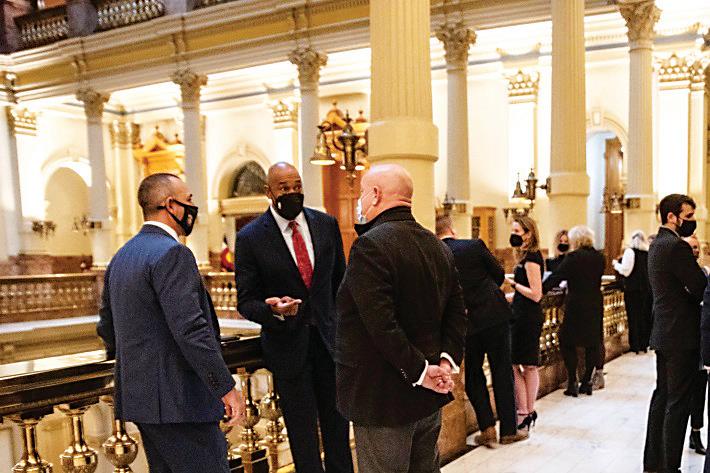
Colorado Republicans rip capital city as they eye November elections
BY JESSE PAUL THE COLORADO SUN

“A toilet bowl.” “A city that no one wants to come to.” “There’s nobody out there that says Denver’s great anymore.”
Those were three takes on the Mile High City last month from three different Republican state representatives. The remarks were made during a news conference recapping the 2022 legislative session and they raised eyebrows given the upcoming election.
The Colorado GOP this year, after four years without a majority in either the Colorado House or Senate, is trying to win back some power in November. They will need the support of voters in Denver, a Democratic stronghold, and its surrounding counties, which make up the state’s population center, to do it.
Nineteen of Colorado’s 35 state Senate districts are in or touch Arapahoe, Adams, Boulder, Broomfield, Denver, Douglas and Jefferson counties. When it comes to state House districts, 35 of the 65 districts are either in or include one or more of those metro Denver counties.
In other words: the road to power in the legislature runs through Denver, which, according to several House Republicans, isn’t such a great place.
“They have basically let the downtown area become a toilet bowl,” said Rep. Matt Soper, a Delta Republican. “You feel safe in our part of Colorado.”
House Minority Leader Hugh McKean, R-Loveland, said Denver is a “city out of control,” referencing crime.
“I would challenge anybody that’s saying that Denver is not on a downward spiral,” said Rep. Colin Larson, a Ken Caryl Republican and one of the only GOP lawmakers in the Denver suburbs. “I would just have to say that doesn’t pass the smell test.”
Douglas County, a conservative stronghold, is really the only metro Denver county where Republicans have consistently won in recent election cycles.
The irony is that Republicans often complain when Democrats criticize rural Colorado. Take, for instance, the condemnation leveled at Marlon Reis, Gov. Jared Polis’ husband, in April after a 2021 Facebook comment he posted surfaced.
In the comment, reported on by The Fence Post in a story about controversy surrounding a prairie dog relocation plan, Reis complained about rural Coloradans whining when state and federal money is sent their way. “You’d best learn not to bite the hand that feeds you,” Reis wrote. “Colorado is more than ranchers, and it’s time to adapt rather than complain.”
Kristi Burton Brown, chairwoman of the Colorado GOP, said Reis’ words were “pathetic” and “disgusting.”
Sen. Kerry Donovan, a Vail Democrat who represents rural parts of western Colorado, said Republicans are talking about Denver in the same vein that Democrats have talked about rural areas. Donovan said the GOP, which often complains about the urban-rural divide, should know better.
“It’s a very dangerous political strategy to create division to try to win elections,” she said.
But McKean said it’s not fair to compare Reis’ remarks to those from him and his caucus. He said he wasn’t castigating any group or person, and that what’s happened in Denver, in his opinion, is the result of Democratic policies. That’s where the politics behind criticizing Denver come in.
“What politics truly is, I think, and especially this year, is a study of contrasts,” he said. “You take a look at what Denver was just a few years ago and the cycle that it’s gone through and in the midst of large policy changes.”
McKean spoke broadly about policies on crime and homelessness. Those are two issues the GOP is promising to tackle if they win in November, along with rising consumer costs.
McKean said the remarks about Denver aren’t part of an election strategy, however. “I think it’s more just a commentary,” he said.
But not every Republican seems to think blasting Denver, whose home prices are soaring as people try to buy into a city with a limited housing supply, is such a good idea.
Sen. Paul Lundeen, a Monument Republican leading efforts to secure a GOP majority in the Senate, said Thursday night during a Colorado Sun event that he thinks Denver “could do better,” but he’s not sure attacking the capital city is a winning strategy.
“It’s not as safe as it was when I first showed up at the legislature eight years ago,” he said. “Do you build a campaign on that? No. You build a campaign on helping the people of Colorado.”
Even Cole Wist, a former Republican state representative who used to be in the same caucus as McKean, appeared to push back on Twitter.
“Like many metro areas, Denver has some things to work on,” he posted, “but it is definitely a great city.”
Sen. Chris Hansen, a Denver Democrat weighing a mayoral bid next year, rejected the criticism wholecloth. He thinks the remarks will hurt Republicans in November.
“Denver definitely has issues like every other city, but this is a wonderful city,” he said. “That is not going to be a winning strategy, I can say with clarity.”
Polis said he doesn’t think the attacks on Denver are ”good politics.”
“I don’t think it ever works to attack part of the state that you want to represent,” he said. “Denver is the cultural capital of our state. You go to Rockies and Broncos and Nuggets games. No area of the state is perfect, but we all value every part of the state. I love Grand Junction. I love Colorado Springs. I love Denver. I love Boulder. They’re all great. I don’t think you hear very many — you certainly don’t hear me — attacking parts of the state that are conservative.”
Democrats hold a 20-15 majority in the Colorado Senate and a 41-24 majority in the House.

Lawmakers and lobbyists are seen at the Capitol on Jan. 12 in Denver at the start of
Colorado’s General Assembly’s 2022 session. PHOTO BY OLIVIA SUN/THE COLORADO SUN
This story is from The Colorado Sun, a journalist-owned news outlet based in Denver and covering the state. For more, and to support The Colorado Sun, visit coloradosun.com. The Colorado Sun is a partner in the Colorado News Conservancy, owner of Colorado Community Media.
Smart security. Professionally installed.
Protection starts with prevention

Know When People and Packages Arrive Peace of Mind Starts Here

Get FREE Professional Installation and Four FREE Months of Monitoring Service*
Use Promo Code 4FREE
CALL NOW TO CUSTOMIZE YOUR SYSTEM 844-251-5445
What did they say, and what did they hear?
BY MICHAEL BOOTH THE COLORADO SUN

Colorado and European Union climate and energy leaders are eager to exchange visitors on policy scouting trips to their equally desirable destinations. Never a shortage of volunteers.
If they were expecting breezy tours of sightseeing highlights and fact-free nights on the town, May 26 was a bracing wakeup call: This Colorado summit with the EU is jammed with dense explications of kilowatt hour clean energy prices, and hydroelectric-tohydrogen storage projects.
And both sides lapped it up.
The European Union’s previous focus on climate change policy has been sharpened by Russia’s invasion of Ukraine and western desires to get completely off Russian fossil fuel imports. Colorado is busy carrying out 57 pieces of landmark energy and climate change legislation passed over three years, and looking for new ideas on how to accelerate cuts in greenhouse gas emissions.
“Climate is no longer a niche policy, it’s all of the economy,” said Mercedes Garcia Perez, leader of the three-day Delegation of the EU (similar to an embassy) learning mission to Colorado.
After an exchange of ideas in downtown Denver on Tuesday, the delegation will also visit the National Renewable Energy Laboratory in Golden, internationally recognized atmospheric research labs and the University of Colorado in Boulder, and energy analysts at the Rocky Mountain Institute.
Here’s a roundup of what EU and Colorado are eager to tell each other:
What the EU delegation is telling Colorado:
• They are fascinated by the buyin from Colorado’s major electrical utilities to retire coal power plants and replace them with solar and wind power. They were impressed by Colorado’s apparent progress toward the goal of cutting 80% of electrical plant emissions by 2030, and wanted to know whether nuclear power or carbon capture and storage underground would be part of those plans. • Hydrogen energy will be a key part of the EU’s clean energy transition. Garcia Perez pointed to a new clean steel plant in northern Sweden that will use hydroelectric power to produce hydrogen, which in turn will be the fuel for the steel furnaces. European car companies are already contracting for the steel, which will be used in part to build electric vehicles. • To cut dependence on Russian oil and gas even faster, EU nations will be demanding more sacrifi ces by consumers and industry. That will include lower speed limits on roadways to save fuel, and restrictions or incentives to get a larger share of power used overnight when electricity is cheaper and more available.

What Colorado o cials are telling the EU:
• Colorado’s transition has benefi ted greatly from close cooperation with the six major electric utilities in the state that have been largely on board with demands for a rapid switch to cleaner energy. Colorado projects are now hearing bids for 2 cents a kilowatt hour for wind, and less than 3 cents for solar with storage, Colorado Energy Offi ce Executive Director Will Toor told the EU delegation, while operating existing fossil fuel plants costs utilities 4 to 4.5 cents a kilowatt hour. • Colorado’s urgency for change has been focused by seeing the initial impacts of climate change: decadeslong megadrought in Western Colorado, more frequent and severe fl ooding from heavy rains or snowmelt and breathing problems from an increasing number of wildfi res across Colorado and neighboring states. • Transportation is the next big sector to target, Toor told the delegation. With so much success in electric utilities’ plans to make the transition, transportation has passed electric power as the largest source of greenhouse gas emissions for Colorado. Colorado’s initially ambitious goal of getting 1 million electric vehicles on the road by 2030 now appears on track, Toor said, and the state must carry through plans to decarbonize the medium to heavy vehicles, such as school buses and delivery trucks.
Some of the 750,000 solar panels of the Bighorn Solar project in Pueblo are shown in this Oct. 21, 2021 photo. The Evraz Steel Mill (shown at the top of the frame) will purchase the energy generated by the array to power a new rail mill currently under
construction. PHOTO BY MIKE SWEENEY/SPECIAL TO THE COLORADO SUN
This story is from The Colorado Sun, a journalist-owned news outlet based in Denver and covering the state. For more, and to support The Colorado Sun, visit coloradosun.com. The Colorado Sun is a partner in the Colorado News Conservancy, owner of Colorado Community Media.


&TheCultureofBusiness

Learnhowcompaniesareimpactingyour liveswithinitiativessuchasgreenenergy, wastemanagement,pollutioncontrols, waterusage,fairlaborpracticesandmore!

ScantheQRcodetoregister, orvisit coloradosun.com/events





Here’s how scientists protect their homes
BY SAM BRASCH COLORADO PUBLIC RADIO
Over the last few summers, Colorado residents have grown accustomed to hearing the same set of recommendations when wildfi re smoke blankets their community: Avoid outdoor exercise. Head inside. Shut the windows.
But experts say those immediate actions only go so far.
Alex Huffman, an associate professor studying air contaminants at the University of Denver, notes smoke can invade a home through cracks and ventilation systems, so preventative measures are necessary to guard indoor air quality and protect people’s health.
“You can’t completely stop it, but there are things you can do to help the amount you breathe in,” Huffman said.
It’s now clear that in the West, and even in many further afi eld parts of the country, wildfi re smoke will be a chronic side-effect of climate change and decades of poor forest management. As wildfi res grow larger and more frequent, a CPR News analysis found Colorado residents now experience between two to four additional smoky weeks every year compared to a decade ago.
The trend worries public health experts because smoke contains tiny particles capable of burrowing themselves deep into the human body. Breathing that material can trigger shortness of breath, asthma attacks and heart attacks. Long-term risks include weakened immune systems and premature births.
There are proven ways to limit exposure even as particulates sneak indoors. Here’s what Colorado scientists have done in their own homes — and what they’d recommend for yours.
Monitor indoor and outdoor air quality
At the start of the COVID-19 pandemic, Huffman brought home a professional air monitor to assist with his work on germ-carrying droplets. When wildfi re season kicked up, it gave him a surprising view into the effect of outdoor smoke plumes.
Even deep in his basement, the instrument showed unsafe levels of particles in the air.
The EPA moves to declare the Front Range a ‘severe’ air quality violator. Here’s why that matters.
Huffman now recommends households explore far cheaper methods to monitor outdoor and indoor air quality. To help manage his asthma, he keeps a careful eye on the EPA’s fi re and smoke map, which tracks nationwide smoke plumes and air quality readings.
To monitor indoor air quality, he purchased an egg-shaped monitor from PurpleAir, which now sits on a table inside the front door of his home in Centennial. It glows green, yellow or red depending on the severity of suspended particulates.
Basic senses are an even cheaper alternative. Colorado air forecasters recommend assuming air quality is unsafe if you can’t clearly see something less than fi ve miles away. Smells can also serve as evidence of wildfi re smoke, but shouldn’t always be trusted. Christine Wiedinmyer, an air quality scientist at the Cooperative Institute for Research in Environmental Sciences at the University of Colorado Boulder, said smoke from far-off fi res doesn’t carry an odor but can be dangerous nonetheless.
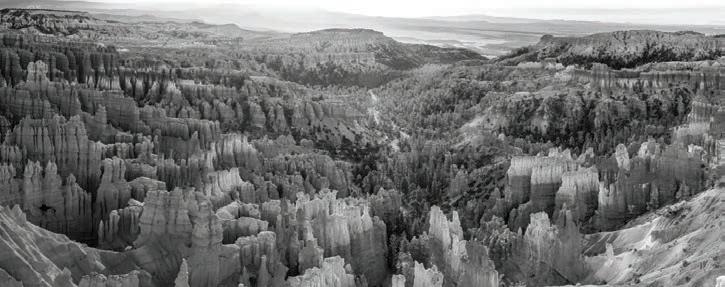
Buy or make a high-quality indoor air fi lter
Huffman has a portable air purifi er in his living room to help remove wildfi re smoke. He demonstrated its effi ciency by turning on a popcorn popper with a fi lthy heating element.
Smoke fi lled the room as his indoor air monitor turned an alarming red. The purifi er then pulled the smoke closer with a gentle hum, bringing particulates back to safe levels in about 30 seconds.
When shopping for an air purifi er, Huffman said it should have HEPA fi ltration to remove particles. He recommends against anything with “plasma” or “ionization,” which doesn’t do much about wildfi re smoke and can add other pollutants to the air.
If a $200 machine is out of the question, another option can be fashioned from a box fan taped to one or several furnace fi lters of a MERV13 grade or higher. The device, called a Corsi-Rosenthal Box, was born after a mechanical engineer tossed out the idea on Twitter.
Huffman installed a number of these contraptions around his house and donated others to his kids’ classrooms. Instructions are available online.
Seal openings and run your air conditioner
Wiedinmyer recommends sealing doors and windows to prevent any wildfi re smoke from making it into the home. If you have an air conditioner, replace the fi lter then set it to recirculate air to further cut indoor pollutants.
Not all homes have the luxury of air conditioning. Huffman has a swamp cooler, which he prefers for its energy effi ciency. Because those systems rely on circulating cooled external air, they aren’t nearly as well equipped to handle poor outdoor air quality.
“It’s just pushing wildfi re smoke into our house pretty effi ciently, which is really unfortunate,” Huffman said.
He doesn’t see an easy way around the problem at the moment. On smoky days, he said households that use swamp coolers or open windows will need to decide if welcoming the bad air is worth it.
Wear a high-quality mask
When you have to head outside on a smoky day, Huffman recommends wearing a high-quality N95 mask to protect against particulates. Don’t bother with cloth masks, though; their mesh isn’t fi ne enough to stop the bits of wildfi re smoke, he said.





Colorado Department of Public Safety Ozone Alert Day.
This story is from Colorado Public Radio, a nonprofi t news source. Used by permission. For more, and to support CPR News, visit cpr.org.
FROM $1,949 $1,699 *
CRIMSON CANYONS & MESAS NATIONAL PARKS TOUR
10 days, departs May - September 2022
Las Vegas • Grand Canyon • Bryce Canyon • Zion •
Capitol Reef • Arches & Canyonlands • and more — Experience the red rocks of these 6 iconic national parks. Travel through deserts, forests, mountains, and to the very edge of the Grand Canyon on this tour.


Solution
© 2016 King Features Synd., Inc.


TRIVIA
1. TELEVISION: Luke’s Diner is a prominent feature in which 2000s TV show? 2. MUSIC: When did The Archies’ “Sugar Sugar” hit the No. 1 spot? 3. ANIMAL KINGDOM: What does the Greek translation of rhinoceros mean? 4. MOVIES: Which movie features the song “Raindrops Keep Fallin’ on My Head”? 5. LANGUAGE: What is the American English equivalent of the British English phrase “drawing pin”? 6. U.S. STATES: Which state’s nickname is the Yellowhammer State? 7. HISTORY: Who is believed to be the fi rst to draw a world map, in 6th century BC? 8. AD SLOGANS: Which company advertised its product with the one-word description “Fahrvergnugen”? 9. GEOGRAPHY: How many states are in Australia? 10. LITERATURE: Which 20thcentury novel starts with the line, “They’re out there”?

Answers
1. “The Gilmore Girls” 2. 1969 3. Horned nose 4. “Butch Cassidy and the Sundance Kid” 5. Thumb tack 6. Alabama 7. Greek academic Anaximander 8. Volkswagen. It’s German for “driving enjoyment.” 9. Six 10. “One Flew Over the Cuckoo’s Nest”
(c) 2022 King Features Synd., Inc.




